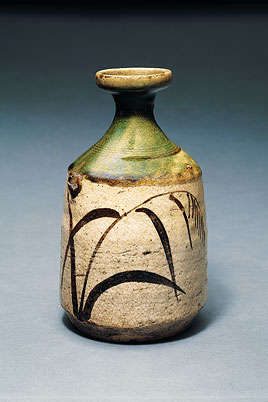
Objects for Daily Use
 |
Sake Bottle Japan, Gifu Prefecture Momoyama period (1573�1600), late 16th century Stoneware painted with iron brown on slip with an overlay of copper-green glaze under glaze H. 7 in. (17.8 cm); Diam. 3 3/4 in. (9.5 cm) Asia Society, New York: Mr. and Mrs. John D. Rockefeller 3rd Collection, 1979.227 |
The modest size of this vessel, its thin neck, and wide mouth suggest it may have functioned as a sake bottle for holding rice wine during kaiseki meals, which often took place before the tea ceremony. The body of the bottle is covered with a thin layer of ivory slip (watery clay), over which hand-drawn designs of iron-brown autumn grass are painted. The autumn grass, a motif often used in Japanese painting, textile, and ceramics, may be suggestive of the season and the transience of life. The green glaze, the iron-brown color, and the pictorial designs on this bottle are all typical characteristics of Oribe ware. This piece is relatively modest in form compared to other Oribe ware vessels, in which distortion and imbalance were deliberately used to create a new kind of artistic equilibrium.